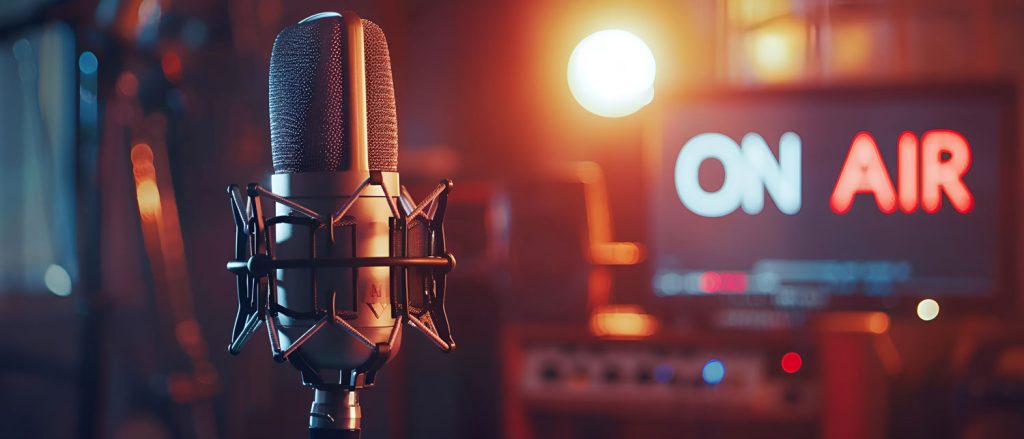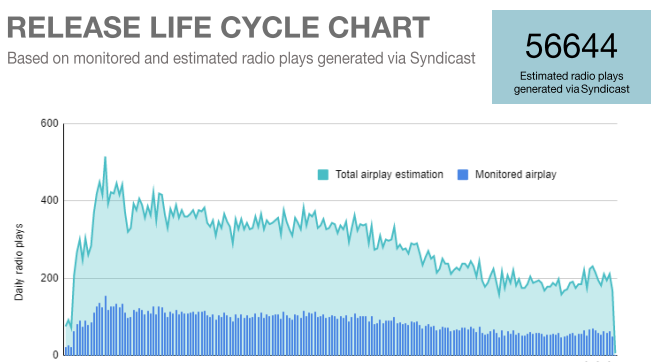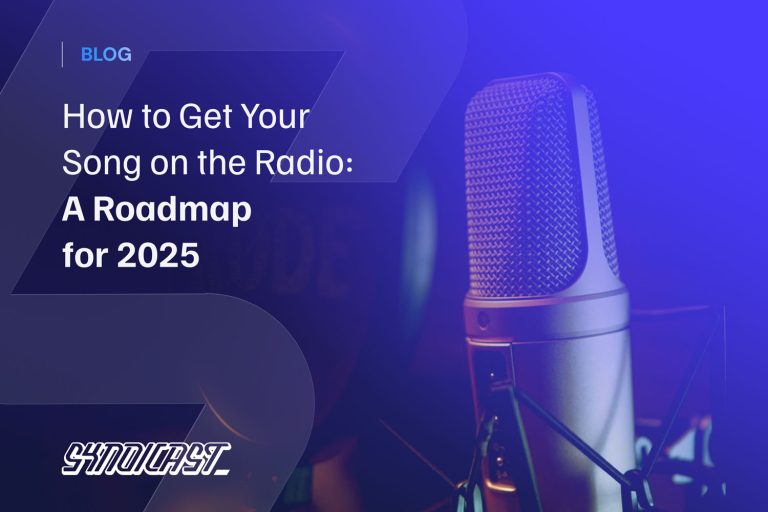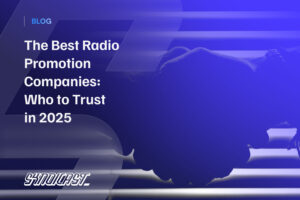In a world saturated with streaming services, the curated, authoritative power of radio remains a formidable force for artist discovery.
Getting your song on the radio through thoughtful music submissions can feel like a monumental task, but it’s an achievable goal. The secret lies in a simple, powerful formula: strategic preparation, a perfect pitch, and persistent, professional follow-through.
This article provides a clear, five-step plan designed to demystify the process and give you a tangible roadmap for getting your music heard in 2025.
We will guide you through transforming your track into a broadcast-ready single, identifying the exact stations that need to hear it, building a professional pitch that commands attention, and leveraging every spin for maximum career impact with music industry professionals.
In This Article…
- How to boost your music career with airplay on commercial radio
- 5-step guide to getting your music played on commercial radio stations
- How to pick and pitch the right radio stations
- Measuring success after you get your music played
Landing That First Spin
Securing that coveted first radio play is the culmination of a well-executed strategy. It’s about more than just having a great song; it’s about presenting that song professionally to the right people at the right time.
The journey begins with polishing your track to meet broadcast standards, ensuring it sounds flawless and fits seamlessly alongside major record label releases.
The next crucial phase is meticulous research – identifying the specific stations and even individual DJ shows that align with your unique sound and audience. You can’t just get your song on radio by sending it out to radio programmers blindly; precision targeting is everything.
Once your track is ready and your targets are identified, the focus shifts to crafting a compelling pitch. This involves creating a comprehensive “pitch pack” with an Electronic Press Kit (EPK), a compelling story, and social proof that demonstrates your existing momentum.
The outreach process itself is a delicate dance of professional communication, requiring a carefully planned email cadence and persistent, respectful follow-up. Often using a radio plugger service is better than sending your music to radio stations manually.
Finally, after you get song on radio, the work doesn’t stop. You must monitor its performance, amplify every spin on social media, and use the data to build momentum for your next move. This can help your music to gain momentum and geat featured on music blogs, Spotify playlists, and generally get some credit with radio tastemakers.
This five-step process – polish, target, pitch, persist, and amplify – is your blueprint for turning radio silence into career-defining airplay.
Step-By-Step: Getting Your Music On Radio
Here is a roadmap to getting radio airplay!

Step 1: Polish the Track – Mastering, Loudness & The Clean Edit
Before a music director or DJ from college radio stations will even consider your track, it needs to meet professional broadcast standards. The raw, unmastered version from your studio session simply won’t cut it – which is something many new artists overlook.
- Professional Mastering: This is non-negotiable. Mastering is the final stage of audio post-production where a track is polished to ensure it sounds its best across all playback systems, from high-end studio monitors to a car radio or earbuds. A professional mastering engineer will balance the sonic elements, optimize the loudness, and ensure your track has the clarity, punch, and dynamic range to compete with other great music on the playlist. There are also online platforms to help with this.
- Loudness Standards (LUFS): Radio stations operate under strict loudness regulations to ensure a consistent listening experience. Your track should be mastered to an integrated loudness of around -14 LUFS (Loudness Units Full Scale). Submitting a track that is too quiet or, more commonly, too loud (a casualty of the “loudness wars”) is a rookie mistake that will likely lead to an instant rejection.
- The Clean Radio Edit Version: Many stations have strict policies against explicit language. To maximize your chances, you must create a “clean” or “radio” edit of your song with any profanity or controversial content removed or blanked out. This version should also ideally be concise, typically between 2:30 and 3:30 minutes, to fit radio programming formats. While it may be a pain for independent artists to create these, they are a music industry standard and can be reused on streaming platforms like Apple Music.
Step 2: Target the Right Outlets – Genre Mapping & Audience Data
Sending your music to the wrong station, especially smaller stations, is a waste of time and resources. Meticulous research is the key to an effective radio promotion campaign.
- Genre and Format Mapping: Start by identifying the radio formats that align with your genre. Are you creating Top 40 Pop, Alternative Rock, Adult Contemporary, Country, or something more niche like Americana or Neo-Soul? Use online radio directories and databases to find stations that specialize in your sound. Listen to these stations to get a feel for their programming and playlists.
- Audience Data: Dig deeper to understand the demographics of each target station. Does their typical listener match your target audience? Do they play music similar to yours? Many larger stations provide media kits on their radio station websites that contain this valuable information.
- Specialist Shows and DJs: Don’t just focus on the main station playlist. Many stations have specialist shows, often in the evenings or on weekends, that are dedicated to new music discovery. Research the DJs who host these shows, listen to their past playlists, and follow them on social media to understand their specific tastes. A personal connection with an influential DJ can be your most powerful asset.

Step 3: Build the Pitch Pack – EPK, Storyline & Social Proof – Music Industry Essentials
Your pitch is your professional introduction to program directors – for both internet radio and commercial stations. It needs to be concise, compelling, and contain everything a music director needs to make a decision. This is typically delivered as an Electronic Press Kit.
Your Pitch Pack must include:
- High-Quality Audio: A link to a high-resolution (320kbps MP3 or WAV digital format) download of your mastered, clean radio edit. Ensure all metadata (Artist Name, Song Title, ISRC code) is correctly embedded in the file.
- A Compelling Bio: A short, engaging artist biography that tells your story and highlights what makes you unique – whether you’re an indie artist or a veteran, this is an essential part of music promotion strategy.
- Professional Press Photos: A selection of high-resolution images that reflect your brand and artist identity.
- Key Track Information: Include the song title, music genre, tempo (BPM), and a list of “RIYL” (Recommended If You Like) artists to give them a quick frame of reference.
- The Storyline: What is the story behind the song? A compelling narrative can make your track more memorable and give DJs something to talk about on air.
- Social Proof: Include links to your website, social media profiles, and any positive press quotes or notable achievements (e.g., impressive streaming numbers, sold-out local shows, opening for a well-known artist).
Step 4: Send, Follow Up, Repeat – Email Cadence, Drops & Exclusives
With your pitch pack ready, it’s time for outreach. Professionalism and persistence are key.
- The Initial Pitch: Craft a short, personalized email to the specific music director or DJ. Address them by name and briefly explain why you think your track is a perfect fit for their station or show. Include the link to your EPK and the audio file.
- The Follow-Up Cadence: Music directors are inundated with submissions. A single email is rarely enough. Plan a polite, non-intrusive follow-up schedule. A good starting point is a follow-up email 7-10 days after the initial pitch, and another a couple of weeks after that if you haven’t heard back.
- Radio Drops: Offer to record a custom “radio drop” for the station (e.g., “Hi, this is [Your Name] and you’re listening to 101.5 The Beat!”). This is a small, professional touch that can help you stand out.
- Offering Exclusives: For a top-tier target station, consider offering them a short-term exclusive premiere of your track before it’s sent to other outlets. This can be a powerful incentive for them to be the first to champion your music.
Step 5: Monitor & Amplify – Performance Monitoring, Socials & Engagement
Getting the spin is just the beginning. You need to leverage that airplay to build momentum.
- Performance Monitoring: How do you know if you’re getting played? This is where a service like WARM and Syndicast becomes invaluable. Our platform provides detailed, real-time airplay monitoring, showing you which stations are playing your song, how often, and in which countries. This data is crucial for understanding your progress and refining your strategy.
- Amplify on Socials: Every time you get a spin, shout about it on social media. Tag the station and the DJ, thank them for their support, and encourage your fans to tune in and request the song. This creates a positive feedback loop and shows stations that you have an engaged fanbase.
- Engage with Listeners: Monitor social media for mentions of your song. When someone posts about hearing you on the radio, engage with them directly. This personal interaction can turn a casual listener into a dedicated fan.
Syndicast’s Success Stories
While sending your music directly to stations is an option, the landscape can be competitive and time-consuming. This is where professional radio plugging services can significantly increase your chances of getting noticed and securing airplay. These services have established relationships with music programmers and understand the nuances of targeting the right stations for your genre.

Consider the impact a dedicated service like Syndicast have:
- Global Reach for Your Music: In one campaign for a well-known artist on a major label, Syndicast’s platform saw the track downloaded by 361 unique radio stations across 54 different countries. This level of reach would be incredibly challenging to achieve independently.
- Significant Airplay Confirmed: Those downloads weren’t just sitting idle. The campaign generated approximately 56,644 verified radio plays (validated with WARM), translating directly into wider audience exposure and potential royalty revenue.
- Boosting Emerging Talent: It’s not solely about established artists. While we generate around 20% of additional airplay for A-listers, for mid sized artists Syndicast’s targeted promotion contributed to 30-70% of all stations that played the track. And for complete newcomers, often we generate close to 100% of their reach. This highlights how a plugging service can be a powerful catalyst for discovery.
What does this mean for you?
Investing in a reputable radio plugging service can:
- Save you valuable time and effort by outsourcing the outreach process.
- Increase your music’s visibility by leveraging existing industry connections.
- Provide validated results, with many services (like Syndicast) using third-party monitoring to confirm airplay.
- Offer additional promotional tools, such as artist IDs and custom intros, to make your submission stand out.
While there are costs involved, the potential return in terms of audience growth, industry recognition, and royalties can make it a worthwhile investment as part of your overall radio promotion strategy. When researching services, look for transparency, a proven track record, and clear reporting on their results.
Connect With Radio Stations Using Syndicast
Navigating this five-step process requires time, expertise, and industry connections. For artists who are serious about results, partnering with a professional radio promotion service is the most effective path forward. Syndicast takes the guesswork out of getting your song on the radio.
Our team of experienced pluggers handles a range of steps within this process.
We offer tiered pricing options to suit different budgets and campaign goals, from introductory packages for emerging artists to comprehensive campaigns for established major labels.
Ready to see your music on playlists worldwide? Explore Syndicast’s Radio Promotion Services today!
FAQs About How To Get Song On Radio
How do I get my song on the radio station?
The most effective method is to follow a strategic, multi-step process. First, ensure your song is professionally mastered and you have a clean radio edit – making suitable for many radio stations. Second, research and identify specific stations and shows that play your style of music. Third, create a professional Electronic Press Kit (EPK) and send a personalized pitch to the music director or DJ. Finally, be persistent with polite follow-ups and monitor any airplay you receive.
How much does it cost to have music played on the radio?
You should never pay a station directly for airplay, as this is considered “payola” and is illegal in many countries. However, you should invest in getting your music professionally promoted, including targeting non commercial radio for radio listening. The cost of a professional radio promotion campaign can range from a few hundred pounds for a small, targeted campaign to several thousand for a major national or international push.
How do I get my songs played on the radio?
The process is the same whether you have one song or an entire album. Each song you wish to promote is called a “single.” You need to treat each single as its own campaign, creating a specific radio edit, building a pitch around it, and targeting the stations that are the best fit for that particular track based on your musical style .










